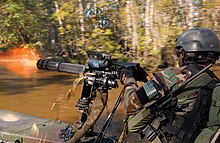
| Part of a series on |
| War (outline) |
|---|
 |
In military science, suppressive fire is "fire that degrades the performance of an enemy force below the level needed to fulfill its mission"[clarification needed]. When used to protect exposed friendly troops advancing on the battlefield, it is commonly called covering fire. Suppression is usually only effective for the duration of the fire.[1] It is one of three types of fire support, which is defined by NATO as "the application of fire, coordinated with the maneuver of forces, to destroy, neutralise or suppress the enemy".
Before NATO defined the term, the British and Commonwealth armies generally used "neutralisation" with the same definition as suppression. NATO now defines neutralisation as "fire delivered to render a target temporarily ineffective or unusable".[2]
- ^ "AAP-6 NATO Glossary of Terms and Definitions, Edition 2014" (PDF). Archived from the original (PDF) on 2020-05-01. Retrieved 2015-11-14.
- ^ Müller, Lars (December 2015). "The Force Intervention Brigade—United Nations Forces beyond the Fine Line Between Peacekeeping and Peace Enforcement". Journal of Conflict and Security Law. 20 (3): 368. doi:10.1093/jcsl/krv005.